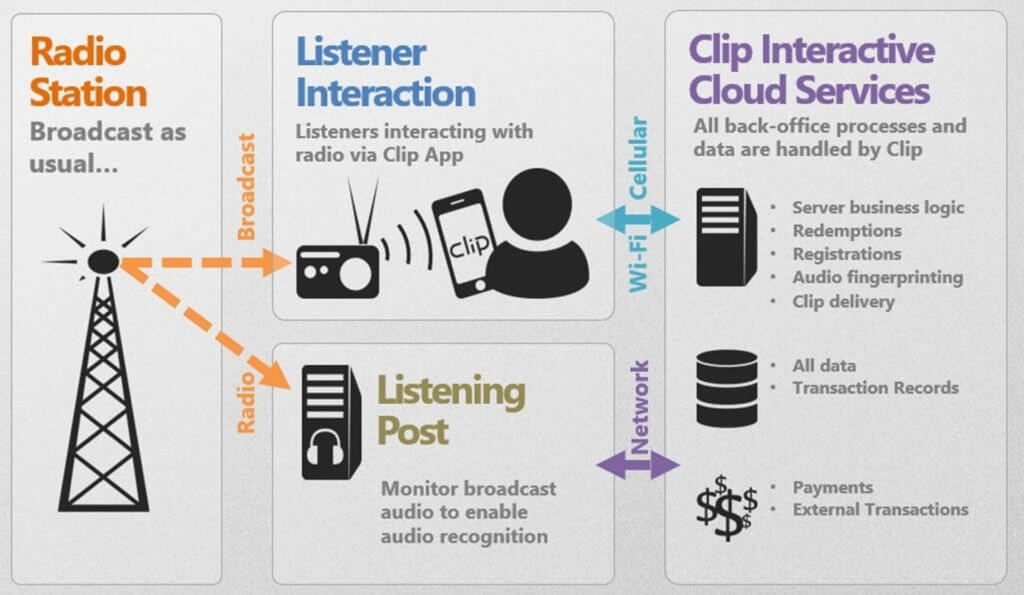 When a serial entrepreneur came to Cardinal Peak with the idea to make radio interactive and thereby capitalize on the deep connection that millions of people have with their favorite radio stations, we were excited to help.
When a serial entrepreneur came to Cardinal Peak with the idea to make radio interactive and thereby capitalize on the deep connection that millions of people have with their favorite radio stations, we were excited to help.
Developing a Streaming Music Service with Custom Capabilities for Interaction
Radio was being left behind in the digital age because the communication was all one direction, unlike the Internet which provides an array of options for two-way (business-consumer) interactions. The basic idea was that a listener could use an app to grab a piece of digital content when they heard something interesting on the radio. Effectively they could “Clip” the content so they could interact with it later as shown by the sample Clips in the figure below.

Recognizing Audio Streams
Step 1 was a feasibility study to see if we could consistently recognize audio in a car driving down the road with the windows open. After some digital signal processing development (and a fair amount of mileage on the car), we felt confident that a mobile app could be used to reliably identify radio content in the most popular radio listening venue – the car.
Prototyping an Interactive Cross-Platform App
The next step was to create a multi-faceted prototype system to enable the testing of the overall vision in a trial market with six radio stations. We needed to develop an inviting cross-platform app for the listener to use to capture their Clips and to manage/transact them.
Designing Custom Hardware
To be able to identify the radio station, we needed hardware to listen to all the local broadcast stations. This custom hardware used banks of radio tuners coupled to Cardinal Peak’s Nexus Peak media processor boards to capture the individual radio streams for use in station identification. These “listening posts” were designed to be completely managed over the Internet so they could be deployed in cities across the nation yet managed centrally.
From signal processing algorithms to user-friendly mobile apps, our cross-disciplinary team executed every aspect of this project to transform radio from one-way communication into an interactive experience.
Identifying Streaming Content
To identify the content playing on the stations, we ran the radio station streams against audio fingerprinting services. We hosted all the software processes on AWS including the content identification processes as well as user accounts and admin controls. These basic components are shown in the following figure.

Launching a New Business for Interactive Streaming Radio
During the development, Cardinal Peak acted as the entire engineering team (peaking at 11 people) from QA engineer to CTO. As the technology matured to the point of being ready to run the first trial of the prototype system with a radio station, our customer hired the necessary business staff. This new staff cohabited in Cardinal Peak’s offices for the first several months while they put together the basic operations, including naming the company, Clip Interactive.
Eventually, Clip secured their own facilities in Boulder and our engineering team traveled to Boulder to support the digital product development side-by-side with the newly hired Clip engineering team. For the launch in Portland, it was all hands-on deck as we rapidly adjusted to the feedback we were getting from the field for this entirely new way of interacting with radio. Shortly after the trial in Portland, the Cardinal Peak portion of the team started rolling off the project as the Clip team took full ownership of the commercial design going forward.
Results: An User-Centered Interactive Streaming Service Design
In the end, the overall system included:
- Computationally efficient signal processing algorithms capable of identifying content with under 4 seconds of audio in an environment with high background noise
- Unique hardware for listening to all the terrestrial broadcasts in a market and sending those audio streams to a cloud-based content identification system
- A wide array of services hosted on AWS for user account management as well as audio content identification
- Android and iOS end-user apps
This multi-disciplinary project was a perfect match for Cardinal Peak’s team as it touched on all aspects of our skills from hardware and embedded firmware, through cloud services and mobile apps.
If you are developing a streaming service or need support for consumer audio product design, let us know.



